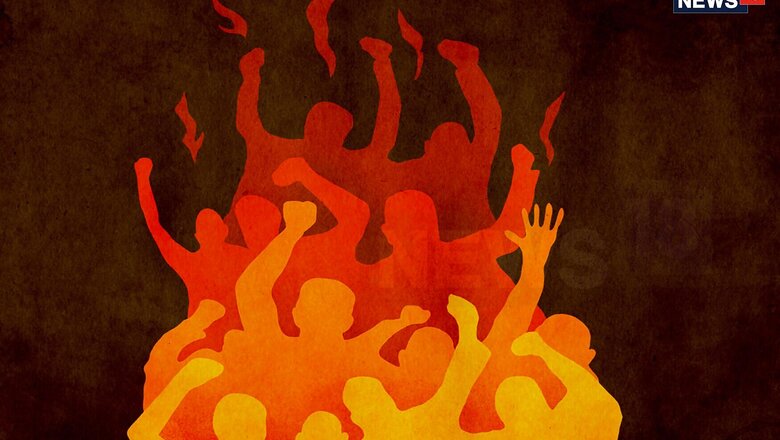
views
First, the rumours about child-lifters roving the area go viral on ‘WhatsApp’.
Then, a few rogue vigilantes take it upon themselves to ‘fix’ the problem — a recipe for the society to turn on itself like a cannibal. All they need now is a weak target.
Enter eight men of a little-known nomadic tribe, politically, socially and economically disenfranchised. They fit the bill as sitting ducks. The chain of events unfolds: rumour-doubt-fear-anger, and finally, lynching.
That’s what happened in Dhule on Sunday afternoon. The five individuals lynched and three who escaped mob fury were from the Dongari Nathpanthi Gosavi community, one of the 650-odd tribes under the Denotified, Nomadic and Semi-Nomadic Tribe (DNT-NT-SNT) rubric. They were at a wrong place at a wrong time doing the wrong work.
An equally poor community in a remote tribal hamlet went after the eight men they perceived as child-lifters; they did what they believed was a quick justice. They didn’t think twice that in a democratic civil society, the job of dealing with the outlawed, even if apprehended by a people, is of criminal justice system, not citizens.
Easy to be mistaken — mistaken by a people with a nasty perception about them — the nomadic communities, who continue to eke out a living as pastoralists, cattle-keepers, by seeking alms, as fortune tellers, as ‘Bahurupiyas’ or street magicians, come to be picked up easy and killed in distant lands by blood-thirsty mobs.
WhatsApp rumours are a trigger. The context is the fledgling criminal justice system and the society’s inability to deal with its collective anxieties, manifested in stories of rape, kidnapping and trafficking of children in the New India. It is prompted by a complete inaction of the police who refuse to act on a tip-off from people.
There are many sub-texts to the Dhule incident and many similarities to a number of other incidents reported in Maharashtra and elsewhere, not only this year, but also in the past. The only different is the rumours today spread on cell-phones through social media apps fast and wide than in the past when there were no mobiles.
Those lynched in Dhule were from Solapur’s arid block of Mangalvedha and all of them were landless. They were doing what they do round the year for their living — either seek alms or move places as fortune tellers.
In Dhule, Marathi media reports suggested that the victims did both: they sought alms and went to the weekly market as fortune tellers. Alongside their own mundane daily struggles went another story. Residents around ‘Reinpada’ village in Dhule’s tribal-dominated Sakhri taluak had been apparently reading a hoax message on WhatsApp that kidnappers were roving the area, looking for victims. The two narratives clashed on Sunday.
A local sought to know the name of one of the victims when he was reading the palm of a young tribal girl to tell her fortune. He became nervous, reports quote police saying on the basis of a preliminary investigation, prompting the local men to nab him and take him to the Panchayat office. It was there that he and his other accompanists were beaten up and lynched by a swollen mob of local villagers. Three of them survived, they’ll soon go back into an isolation and forgotten by the rest of the society.
The Dhule police said the victims might have escaped death had the mob understood their language.
Counting the incident in Dhule, at least 19 people in 11 states have been killed in lynchings and public killings since the beginning of May 2018, and countless others injured.
The following case is more of an irony. Sukanta Chakrabarty was appointed by the government of the state of Tripura to tour its villages and dispel social media rumours about child-kidnappers. A week or so ago, he was mistaken for a kidnapper and killed by four young men in the village of Kalacherra.
On Monday, the police managed to save five migrants, including a two-year-old, in Malegaon, a textile town where they had gone to escape hunger back in their native village in Parbhani, one of the most arid and drought-prone districts of Marathwada in central Maharashtra. Here too, people failed to understand them, their language, their compulsions, and their desperation —they needed food to subsist. They got stones.
In 2012, in a similar incident, wild rumours and reports that an active gang of burglars disguised as women was active in the area for quite some time, took a bizarre turn in Nagpur when an angry mob unleashing a collective brutality, chased and stoned to death three sari-clad men belonging to Nath-Jogi tribe.
The Dhule incident ran similar to the one that happened in Nagpur, with the same effect. Victims were Dongari Nathpanthi Gosavi, who come from Mahadipur, a village in eastern Vidarbha’s Buldhana district. The community that remains abjectly poor, completely disconnected with the dominant communities, and live a fairly recluse life usually seeks alms in the absence of any other livelihood option. It remains uneducated. Very few ever go to school. Sometimes, they double up as landless labourers through the farming season but migrate to cities in summers to subsist on the food and money people give them. Their tradition occupation includes of playing fortune tellers.
Four men, clad in sarees and wearing heavy make-up, had alighted from an auto in a city locality where they would sing songs, play an act from an epic, and seek alms before returning to their shanties on the city fringes.
Driven by fear that was triggered by rumour, the local vigilantes targeted them, chased them and then stoned them to death as others joined in a free for all. No one knew why they were beating the four hapless men.
The police managed to rescue one of them, Punjab Laxman Solanki, the lone survivor of that incident.
The Nagpur bench of Mumbai High Court, while hearing a petition filed by a social organisation working for the betterment of nomadic tribes, had in 2013 asked the state government to give the family members of the three deceased men a hiked compensation of Rs 5 lakh each, but structural problems remain unaddressed.
In 2008, noted social worker from Solapur, Balkrishna Renke, who headed the National Commission for Denotified, Nomadic and Semi-Nomadic Tribes set up by the UPA-I government, submitted a 139-page report on the socio-economic status of what is a rubric of communities living beyond the margins; some of them are not even part of the Census data. The recommendations of that Commission are yet to see the light of the day. Among others, how to bring them into the mainstream, how to stabilize them economically.
As Renke Commission explained: these communities have a long history of marginalisation, neglect and oppression, first during the colonial rule, and subsequently, in independent India.
When the Commission began its work in mid-2006, its major concern was: How to identify the Denotified, Notified and Semi-Notified tribe; how to define them; and how to bring them under the Statute book.
During the British rule, due to specific administrative as well as law and order reasons, some of these tribes were ‘notified’ as being ‘born criminal’ under a series of laws starting with the Criminal Tribes Act of 1871. This law that saw crime as a ‘hereditary profession’ was repealed in 1952, and the communities were ‘de-notified’ as such, but in the police training manual or in public perception, communities continue to be seen as criminal tribes.
The Renke Commission estimated that put together, the DNT, NT and the SNT would comprise about 7 percent of India’s population and consist of about 500 different clans.
Despite an authentic data about their numbers, the Renke Commission pegged the population of the DNT-NT-SNTs at approximately a 100 million. One of its recommendations was that the 2011 Census must enumerate their population that could then become a base for the government to devise a welfare strategy.
The initial concern about these communities after our independence from the British rule slowly petered out. But with the passage of time, and particularly post liberalisation, these communities have become invisible.
It is partly because these communities are largely politically ‘quiet’ — they are neither organised, nor have an endogenous vocal leadership, let alone any political patronage.
As the recent and past violence against these communities show that while they were once considered a threat to the society, today the society has become a threat to them.
(The author is a Nagpur-based journalist)




















Comments
0 comment